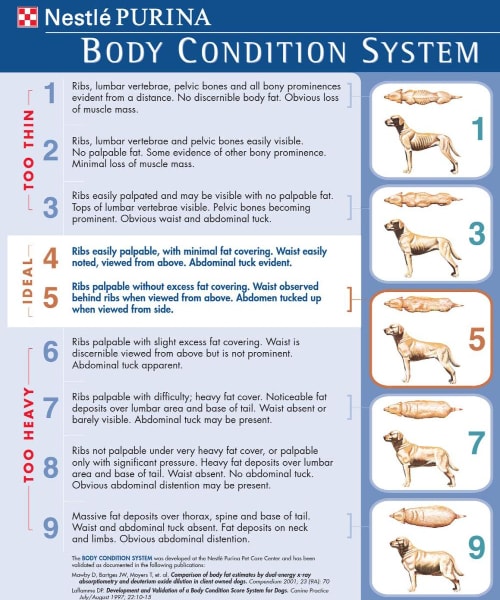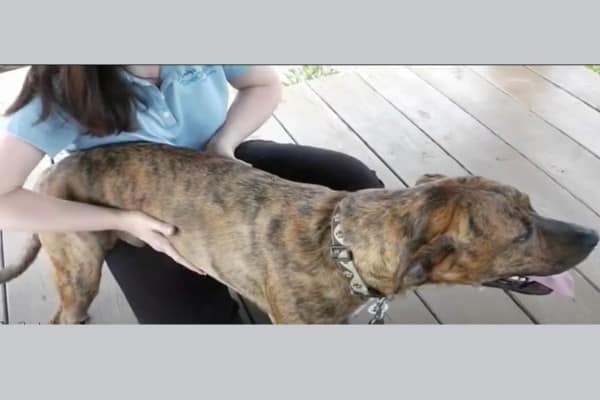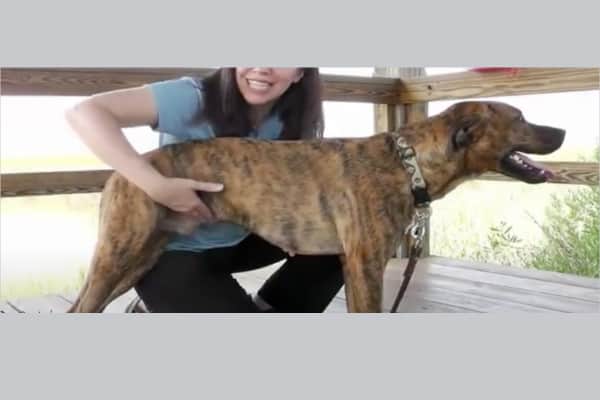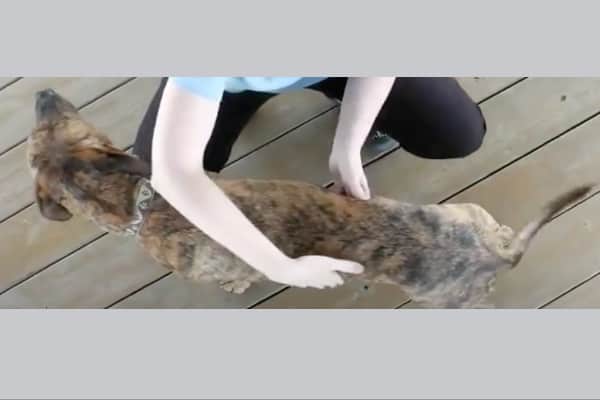Do you know your dog’s body condition score? Through an easy, hands-on assessment, integrative veterinarian Dr. Julie Buzby shows you exactly how to determine whether your dog is overweight, underweight, or just right. Plus, she shares the Purina Body Condition score chart, a how-to BCS video, and provides seven weight management tips to help get your dog to an ideal weight.

Could your dog be overweight or even obese? If so, your canine companion has a lot of company. A 2018 study from the Association for Pet Obesity Prevention found that almost 56% of all the dogs in the United States are considered overweight or obese.
Obesity can shorten your dog’s life span by up to two years and predispose him or her to a variety of conditions (more on this in a bit). This means keeping tabs on your dog’s weight is crucial to his or her well-being.
But how do you know the optimum weight for your dog? As you are about to learn, the answer to that question doesn’t necessarily lie in the number on the scale. Often, determining your dog’s body condition using a canine body condition scoring system is the way to go.
What is a body condition score for dogs?
The term “body condition score (BCS) refers to a hands-on assessment of a dog’s weight. It’s based on a dog’s frame as opposed to straight body mass.

Why use a body condition score?
Many veterinarians prefer to consider the body condition score for dogs—rather than how many pounds they weigh—when determining if dogs are overweight, underweight, or at an ideal weight. This is the case because it often gives a more accurate representation of the dog’s weight.
Here’s why. When you weigh your dog, the scale does all the heavy lifting. But how exactly do you know what that number should be? Is your Labrador Retriever supposed to be 65 pounds or 80 pounds at an ideal weight? Well, it depends on your dog’s frame. This is where learning how to find your dog’s body condition score can be so helpful.
The body condition score system takes a different approach. Rather than relying on the number on the scale, body condition scoring uses touch and visual inspection, combined with a dog body condition score chart, to assess whether your dog is at a healthy weight.
How do you body condition score your dog?
While it might sound a bit intimidating, I promise that finding your dog’s body condition score is pretty simple. All you need is a body condition score chart made for dogs and your dog.
Compare your dog to Purina’s body condition score chart
Using the chart shown below, the Purina body condition score chart, dog parents can easily find their dog’s BCS. Since it ranks the dog’s body condition score 1-9, it provides enough options to be able to easily determine which category your dog falls into. And the Purina body condition chart gives you both visual and written descriptions to help you find your dog’s number.

The 9-point body condition score places dogs into three groups: underweight, overweight, and ideal weight.
- A body condition score of 1-3 is considered underweight or too thin.
- A body condition score of 4-5 is considered ideal.
- A body condition score of 6-9 is considered overweight or too heavy.
Use your hands and eyes to find your dog’s BCS
The chart above is a great reference. But I understand that when trying to determine the Purina body condition score, dog parents may still have some uncertainty. So I wanted to provide an easy, three-step guide that explains how to calculate a dog’s BCS.
Step 1: Feel your dog’s chest and ribs.
First, gently run the palms of your hands along your dog’s chest and rib cage. Are the ribs easy to feel? An overweight dog will have a layer of fat over the ribs. An underweight dog’s ribs will feel bony due to minimal fat covering. And if your dog is at an ideal weight, the ribs should be easily palpated with gentle pressure.

To get an idea of what your dog’s ribs should feel like, try this easy comparison from board-certified veterinary nutritionist, Dr. Jackie Parr:
- First, run the fingers of one hand over the bones in the back of your other hand between the wrist and the knuckles.
- Then with the same amount of pressure, run your fingers over your dog’s ribs.
- Compare the two. For a dog with an ideal body condition score, the bones in the back of your hand and your dog’s ribs should be feel similar with the same amount of pressure.
Step 2: Check for an abdominal tuck.
Next, crouch down and look at your dog’s shape from the side. Inspect where the chest cavity transitions to the belly and the belly meets the hind legs. Does the area have a tapered appearance? With an ideal body condition score, dogs should have an abdominal tuck—much like a sleek race horse.
Keep in mind that this is somewhat breed dependent. For example, if you have a deep-chested dog, it takes a significant amount of body fat to hide the abdominal tuck completely. So if the abdominal tuck is less well defined, this can indicate the dog’s BCS is too high.

Step 3: From above, check for a waistline.
Third, look at your dog from a bird’s-eye view. Does your dog have a tapered waistline? As you can see from the photo below, when viewed from above, your dog should have a slight “hour glass” appearance. On the other hand, with a high BCS, dogs tend to have an oval or rectangular shape from above.

Watch a dog body condition scoring video.
Alternatively, if you are more of a visual person, I have also turned this three-step process into a BCS video. For an easy tutorial on how to body condition score your dog, check out the video below.
Use the Purina body condition scale to find your dog’s BCS
Now it’s time to compare your findings to the Purina body condition scoring system for dogs that I shared above. How did your dog measure up?
How can you get an overweight dog back to an ideal weight?
If you learned that your dog’s score is above the ideal weight (BCS 6-9), don’t give up hope! There are plenty of tools available to get your dog back to an ideal weight. To help you get started, here are seven quick tips on canine weight management.

7 canine weight management tips
- Find a way to connect emotionally with your dog that doesn’t involve food. For example, a long walk is a great way to bond with your furry friend.
- Increase your dog’s activity level. Just like in people, weight loss in dogs requires burning more calories than he or she takes in.
- Measure the amount of food you serve your dog using a kitchen scale. Or if you don’t have a kitchen scale handy, use a genuine measuring cup—not a coffee can, ceramic mug, or random scoop. Accurately measuring your dog’s food will keep extra calories from sneaking into your dog’s diet.
- Remember that the calories from treats add up quickly. Instead of packaged dog treats, consider using vegetables your dog can eat as a treat.
- Substitute low-sodium canned green beans or cooked fresh green beans for a portion of your dog’s meals. This substitution creates a sensation of fullness while reducing caloric intake.
- Get the entire family on board. If you follow the feeding plan strictly, but your spouse feeds treats all day long, you may become frustrated. To get the plan to work, everyone needs to work as a team—for your dog’s sake.
- Learn more weight management tips from board-certified veterinary nutritionist Dr. Jackie Parr in my article on how to help a dog lose weight. Or read Dr. Bentley Richard’s article, Is my dog overweight?, for additional ideas.
Partner with your veterinarian to develop a weight loss plan tailored to your dog
Additionally, as with all of your dog’s health needs, it is a great idea to consult your veterinarian about your dog’s ideal weight and diet. Your vet can help you formulate a plan and track your dog’s progress.

A vet visit can get your dog off to a good start
Your veterinarian will likely start by getting a history and performing a physical exam. Based on your answers to the questions and the results of the exam, your vet may want to run blood tests or other diagnostics. Sometimes diseases like hypothyroidism in dogs and Cushing’s disease in dogs can contribute to weight gain, so it is important to find and address them promptly.
The vet can help you determine the type and amount of food to feed your dog
After discussing your dog’s diet history and completing the exam, the vet will help you formulate a plan. He or she may recommend changing to a food that is formulated to help with weight loss. If this is the case, your vet can make more specific recommendations about what is right for your dog.
Additionally, your vet can help you figure out how much food to feed your dog each day. The good news is that feeding guidelines need not be mysterious or arbitrary. The vet can use a mathematical equation, which factors in your dog’s age, gender and activity level, to determine a daily caloric requirement for your dog. (And you can also use a dog caloric requirement calculator yourself to get an idea of how much to feed your dog per day).
However, keep in mind that this number isn’t guaranteed to be perfect. Based on your dog’s current calorie intake and body condition score, the veterinary team may suggest modifications to the calculated number. Each dog is an individual. So he or she may need more or fewer calories than the “average” dog to reach or maintain an ideal weight.
Regular weigh-ins at the vet can keep your dog on track
As you work on helping your dog lose weight, keep in mind that dogs who are “dieting” should have frequent weight checks at the vet’s office. Losing about 1% of body weight per week is the goal.
If your dog is losing weight too quickly, this could lead to loss of muscle mass, so it is important to keep an eye on your dog’s weight. And on the other side of the coin, if your dog isn’t losing much weight, you will need to modify your approach.
It can be a good idea to ask your veterinarian how he or she wants to do the weight checks. You may be able to weigh your dog during office hours without an appointment. But your vet may also want to see your dog periodically for an appointment, especially if weight loss isn’t going as expected or you have any concerns.
Also, you can ask the veterinary team to provide you with a computerized graph showing your dog’s weight history. I recommend hanging it on the refrigerator for accountability.
What are the benefits of keeping your dog at an ideal weight?
Now that you know how to find your dog’s body condition score and how you can partner with your veterinarian to help manage your dog’s weight, let’s talk about what’s in it for your dog.
In one landmark study, researchers determined that dogs maintaining an ideal weight can live over two years longer than their overweight counterparts. That’s potentially 24 more months of happiness for both ends of the leash!

Risks of obesity in dogs
Why is this the case? Unfortunately, many chronic illnesses are associated with an increased weight and body condition score.
Orthopedic conditions
Being pudgy puts unnecessary stress on the discs in the spine, increasing the chances of intervertebral disc disease (IVDD in dogs). Plus, the combination of extra weight on the joints and inflammatory molecules secreted by fat can lead to joint degeneration and osteoarthritis in dogs. And increased body mass also predisposes dogs to hip dysplasia in dogs or torn ACL in dogs.
Respiratory and cardiac problems
When dogs have extra fat deposits around their neck and chest, their body has to work harder to breathe. This is one of the reasons that weight loss is part of the treatment plan for collapsed trachea in dogs or chronic bronchitis in dogs.
Plus, one study indicated that higher abdominal fat content (i.e. abdominal obesity) may predispose dogs to heart disease in dogs. However, the connection isn’t well understood yet.
Diabetes
While not directly linked to diabetes in dogs, obesity does seem to indirectly contribute to a dog becoming diabetic. It increases the chances a dog will develop pancreatitis in dogs, a diabetes risk factor. Additionally, obesity makes a dog’s body less responsive to insulin, the hormone that controls blood sugar. However, insulin resistance does not cause diabetes in dogs like it does in cats and some people.
Take your dog’s health into your own hands
The good news is that you have the ability to decrease the chances that your dog will suffer from these obesity-related issues. By understanding your dog’s BCS, and checking it regularly, you’re well on your way to helping your canine companion live his or her best life. In partnership with your vet, you can get your dog’s paws on the path to a trim figure and better health.
What questions do you have about using a dog body condition scoring system?
Please comment below.


Hi my dog Gracie is a #7 on the scale. I have cut back her food but she has osteoarthritis and her knees are really bad. She’s on Amantadine HCL and she gets her shot of Librela once a month. She’s a big dog naturally with a very big chest. Because of her knees I can’t exercise her much. Do you have any suggestions for exercising her? She tries so hard to play and run but when she does she can hardly move afterwards. She’s 10 and weighs 100lbs. She is a pit bull boxer mix. She was diagnosed with kidney disease last year. I have her on the Purina prescription food. She gets fed 1/2 cup in the AM with 3 slices of dried sweet potato. Most mornings she only eats the potatoes and in the evening she gets 1/2 cup of dry and 1/4 can of wet. I limit treats which are typically the sweet potatoes or fruit. I know she needs to lose weight to help the pressure on her knees but I don’t know what to do for exercise. Any suggestions on the weight loss and exercise would be greatly appreciated.
Thanks,
Laura
Ps- I am purchasing the toe grips. She’s been slipping a lot lately. I don’t want her to hurt herself.
Hi Laura,
I am sorry Gracie is struggling with her weight due to arthritis pain. From what you describe, I think she would benefit greatly from working with a veterinary rehabilitation professional. There are many balancing and core exercises that would allow Gracie to “work” and burn calories but that wouldn’t put strain on her knees. Also, most rehab facilities have an underwater treadmill. That and swimming are great ways to exercise that don’t require a dog to carry their full weight on their joints. Hoping the ToeGrips will be a game changer for her traction and stability around the house. If you have any questions, concerns, or want help choosing the right size, don’t hesitate to reach out to our expert customer care team at: [email protected]
Wishing you and your sweet girl all the best!
Hi , our jack Russel a bit over weight now has diabetes and will not eat still walks around the garden eating a bit of grass , but not herself at all even not eating food .
Very sleepy and has lost her get up and go .
The vet has recommended taking her in for an drip feed for a day to hydrate and feed , would this be normal , 6 years old and only drinks water so far for two days . .
Hi Stanley,
I am sorry your pup is not doing well and understand your concern. From what you describe, I am worried she may have developed a condition called diabetic ketoacidosis. This can be a life-threatening emergency. While I can’t be certain without examining your pup myself, I do think taking her in for a thorough evaluation is best. If she does in fact have ketoacidosis, then hospitalization with IV fluids would definitely be necessary. I will attach links to other articles with more information. Hoping for quick answers and a clear path forward. Praying for a positive outcome for your sweet girl.
1. My Diabetic Dog Won’t Eat: Now What?
2. Diabetic Ketoacidosis in Dogs: A Vet’s Guide to DKA in Dogs
I love the information provided on BarkWorthy – always something to help me help my furry family members. So many people end up overfeeding/treating their pets thinking it equates to giving love. Guess moms and grandmoms made us good food out of love, but we need to make sure we give belly rubs, ear scratches and spend quality time with our pets to show we care and keep the treats to a minimum so as not to cause health issues.
Thanks so much for all your support, Denise. It means the world to me! YES! I couldn’t agree with you more that physical touch and quality time are most dogs’ biggest treats! We have to find a way to cut back on calories for those guys and increase the love!
I would agree that consulting your vet in regards to your pet’s health is a good idea. That is smart to get your pet’s weight checked, if you are concerned they are getting heavy or light. I am glad to know that veterinarian’s are able to asses your pet’s health and help them.